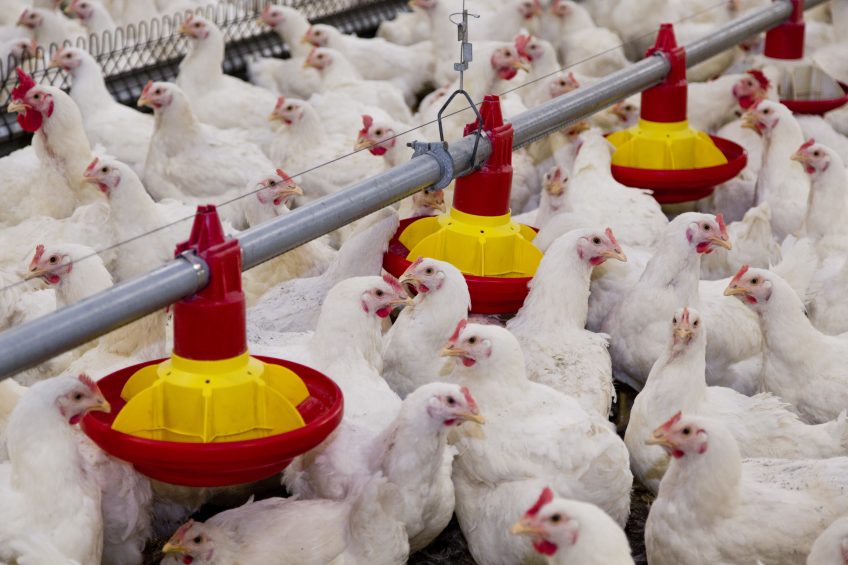Boosted medium-chain glycerides, an AGP-free feed

Reduction, and ultimately, the ban of (in-feed) antibiotics from animal feed, does not come without its challenges. An overall approach, including non-antibiotic in-feed specialties, can help cope with these challenges.
Farm management, good hygienic practices and extra balanced nutritional feed composition (e.g. banning excessive protein levels whilst maintaining digestible amino acid-level, ensuring appropriate energy levels) are essential steps for thriving with antibiotic free feeds.
Another worthy step to consider is non-antibiotic in-feed specialties. Medium-chain (MC) products and phytogenics are known to be very promising in this context. Literature and trials have shown effect on the animal itself as well as on the microbiota present in their gut. Therefore, a double manner to assist birds to cope with the above mentioned difficulties.
Medium-chain glycerides versus pathogens
Medium-Chain Glycerides (MCG’s) consist of medium-chain fatty acids esterified with glycerol. The medium chain fatty acids provide the activity of the product. Binding them to glycerol, will get the MCFA’s to be slowly released (by lipases) throughout the GIT. This ensures the product is active at the place of greatest impact: the small intestine.
Medium-chain products have a greater antimicrobial effect than short chain fatty acids and long chain fatty acids. Especially towards Gram(-) bacteria. The chain length determines the antibacterial effectivity towards specific bacteria. For example, caproic acid (C6) is more active towards E. coli compared to capric acid (C10). Along their direct antibacterial effect, medium-chain fatty acids decrease virulence gene expression of Salmonella and thus invasion in intestinal epithelial cells in broilers, even at subinhibitory level.
Reducing Salmonella colonisation
Reduced level of colonisation of caeca and internal organs of broilers in a Salmonella Enteriditis challenge has been validated. Similarly, an in vivo-study reported that medium-chain products can reduce early Salmonella colonisation in turkeys. Supplementing C8 to feed for 10-day-old broiler chicks, orally challenged with Campylobacter jejuni reported reduced caecal Campylobacter content in the C8-feed.
Besides effect on microbiota, gut morphology effect of in-feed MC products has been documented: increased villus to crypth ratio’s in the small intestine. Increased V/C favours digestibility and absorptive capacity of the small intestine. Caproic and Caprylic acid are even reported to meet the energy requirements of colonic epithelial cells in vivo as well as butyrate, which is commonly acknowledged for this.
MCG’s are compatible with other bioactive products, like phytogenic compounds. Amongst other effects, carvacrol and thymol were reported to improve intestinal integrity and modulating immune responses in Clostridium perfringens challenged broiler chicks. Their destructive effect on chicken Eimeria oocysts is published. The mechanism of the direct antibacterial effect of these components are inline with the mechanism of medium-chain compounds.
Improved performances with upgraded/boosted MCG’s
Medium-chain glycerides upgraded with aromatic compounds, called ‘AveMix Plus’ was tested in several (field) trials by AVEVE. First at elevated dosage rate, but even at basic dosage rates nice performance effects have been shown. In a Belgian farm a standard control feed was fed to 30,000 broilers in one stable and a similar feed with an elevated level of AveMix Plus on top was fed to 34,000 broilers, see Figure 1. Both feeds contained a base level of organic acids.
The number of birds per square meter were the same in both stables. During the trial the broilers had an extra challenge caused by unusually warm weather. The birds fed the combination concept needed less feed to obtain similar growth rate compared to the control feed. A 29% lower mortality percentage was registered for the Plus fed birds. This trial was repeated at another farm with stables of respectively 42 015 birds for the control feed and 42 120 birds for the test feed. Performance results were convincing: 3% better growth rate in addition to a better FCR and lower mortality percentage. Faeces quality was observed by the farmer as to be better in the test stable.
AGP free feed worthy
All observed effects above, indicates a more optimal use of energy supplied by the feed upon AveMix Plus addition to the feed, giving them more ‘room’ for growth. More efficient use, and more economical use of animal feed is the end goal which every farmer pursues.













